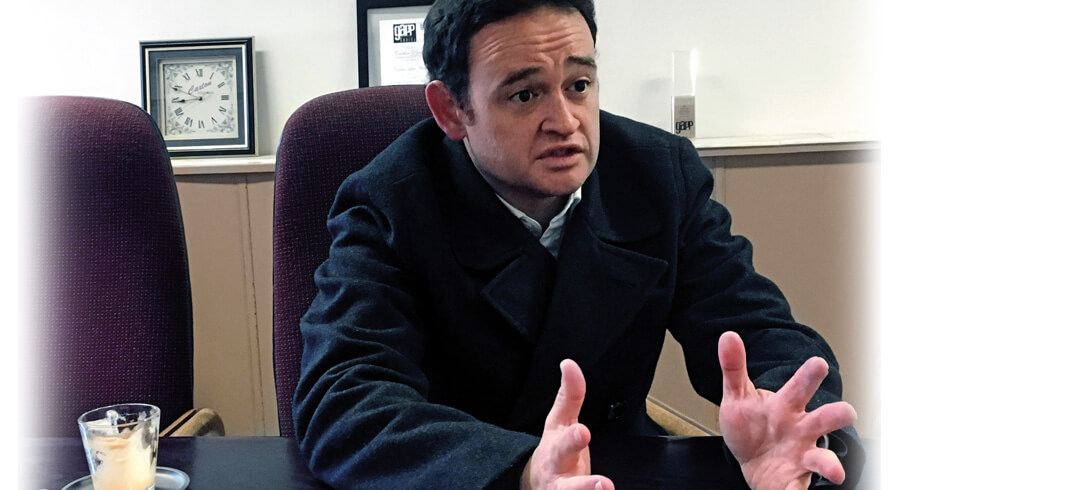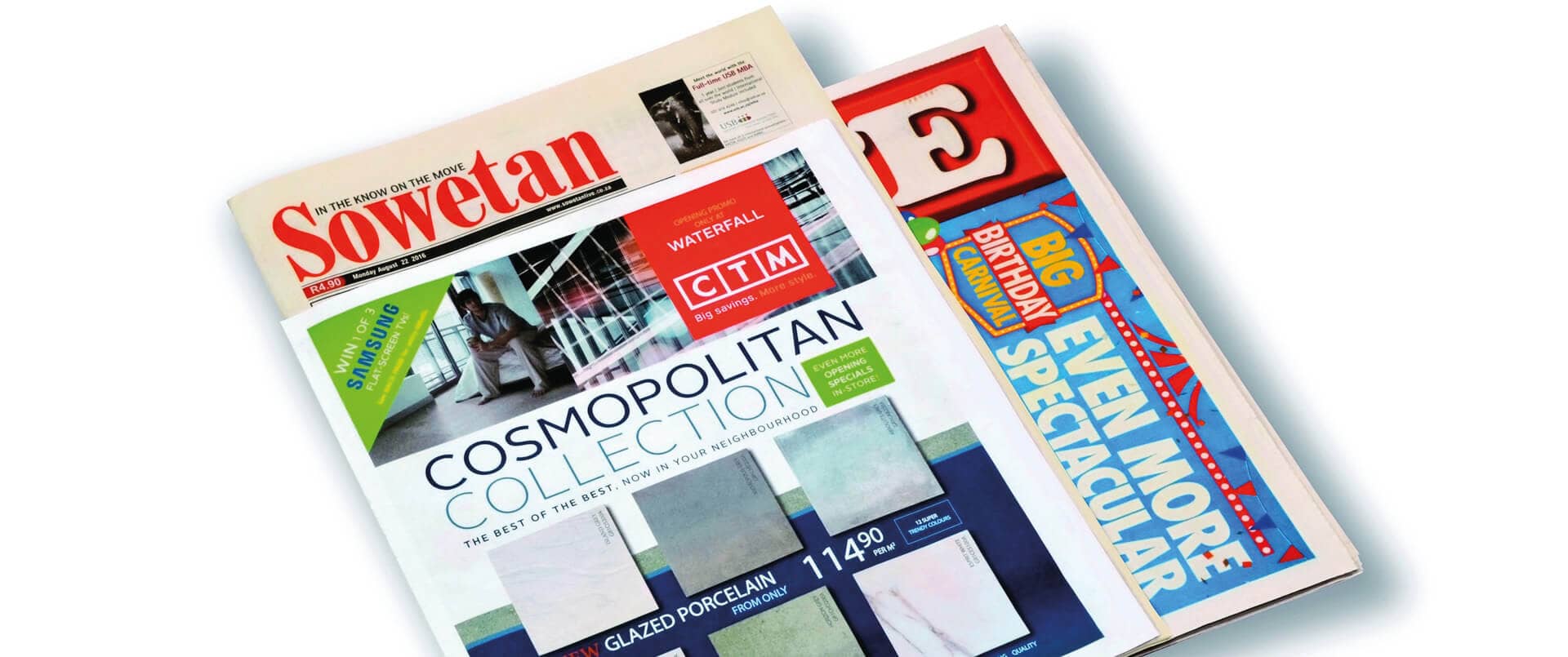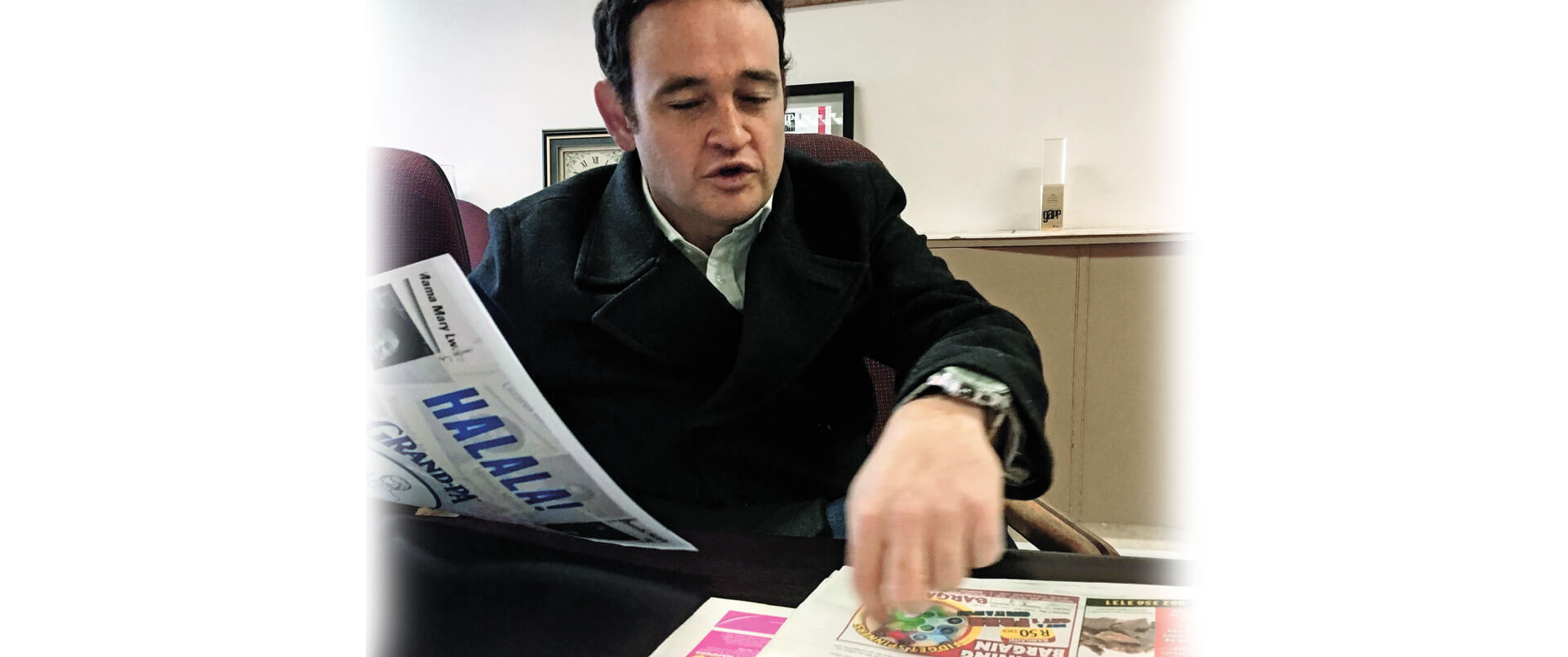“The Message Reaches the Consumer through the Local Newspaper”
08/08/2017
Caxton Local Media invests in local newspapers, which has a positive impact on the printed advertising market in general and especially for the insert business. ”Panorama” has spoken to the CEO Jaco Koekemoer about why inserts are still such a powerful tool and how Caxton can attract new customers with different forms of advertising such as PowerWraps.
“Panorama”: How popular are inserts in South African newspapers?
Jaco Koekemoer (Managing Director Caxton Local Media and Coldset Printing at Caxton Group): Local papers in South Africa continue to be the preferred medium for retailers and other businesses to bring their advertising leaflets and messages to consumers. The reason for this is that local newspapers contain relevant information for the local community, which can only be found inside their local paper. Consumers want to be informed about what is happening close to home. That is why the local papers are still the central platform for this type of news. Inserts have become an important part of local newspapers and consumers expect to find a wealth of different offers inside their local papers.
How has the newspaper insert business changed in South Africa in the past five years?
Due to the tough economic situation we face in South Africa, retailers have mostly targeted the week where consumers get paid for their advertising. This leads to the first three weeks of the month being smaller in the number of inserts handled and the last week being an explosion. Also with the general drop in circulation of daily newspapers, local weekly papers carry more inserts than usual. Our month end week at our Johannesburg plant regularly exceeds 20 million inserts for the local papers alone.
 Jaco Koekemoer: “90% of our newspapers, especially in metropolitan areas, are distributed free to households within a specific area.”
Jaco Koekemoer: “90% of our newspapers, especially in metropolitan areas, are distributed free to households within a specific area.”
How is the insert business going for the newspapers of the Caxton Group?
Despite the difficult economic conditions in our country, our insert business has remained fairly stable with moderate growth. The last week of November 2016 was the busiest inserting week to date at our Johannesburg factory. 26.5 million inserts were inserted into 53 local newspapers in a single week. If you include the daily newspapers, the total number of inserts that we inserted into the Johannesburg newspaper was in excess of 30 million.
It was a crazy week to say the least. The largest publication had 34 individual inserts. In order to do this, we had to run the product through the ProLiners four times using pre-printed jackets. The weight of the total product was 100 tons and we could only fit eight newspapers into a bundle - they were that thick. The paper deliverers who had to distribute the newspaper had sore arms and shoulders after delivering the newspaper to every household in the local newspaper’s area.
How are you expecting your insert segment to develop in the coming years?
Unfortunately, the circulation of daily newspapers and weekend papers continues to drop. To save costs the publishers have to cut print orders and this has a direct effect on insert volumes. I do, however, believe that this is starting to bottom out and large daily newspaper publishers have taken cost savings into consideration and now need to sustain print orders. 90% of our newspapers, especially in metropolitan areas, are distributed free to households inside a specific area.
At Caxton we continue to invest in local newspapers. We have just purchased a share in an additional three newspapers and continue to monitor areas where we can expand our footprint or start a new paper. This is positive for the future of inserts in the country.
In South Africa, are you in competition with other forms of distributing leaflets, like stand-alone bundles without an advertising carrier that are mailed directly to mailboxes?
In South Africa, people do not have the same amount of trust in our mail system as in 1st world countries. Courier services remain expensive. Some retailers make use of knock and drop companies where leaflets get delivered on their own to households. Since there are no costs for the inserts, no editorial content and no audit fees on the distribution this is obviously a cheaper method.
The question, however, is after spending so much money on printing, is it not better to trust an audited distribution method than one where the consumer expects to find your pamphlet inside his local newspaper. This is the last cycle in your print marketing strategy but probably the most important. Making use of a quality audited local newspaper means your message reaches the consumer and he can read it at his leisure in the relaxed environment of his own home, hopefully on his favorite couch with his feet up.
 Does the insert business generate additional sales for your company because you also print inserts in-house?
Does the insert business generate additional sales for your company because you also print inserts in-house?
It is a package deal that we offer. We have ten printing plants for our local newspapers in South Africa and four commercial printing plants. Our publishing company offers more affordable insert rates if the customer prints with any of these 14 print plants. We have 141 local newspapers out there, which are printed at these ten newspaper printing plants. Three of these factories also print daily and weekend papers for some of the largest publishing companies in South Africa. When customers print their leaflets with us, we can optimize logistics to ensure lower transport costs and the discount that we offer ensures an attractive package. This makes us the number 1 print and publishing solution for loose inserts.
Do your newspapers include inserts that you have finished, i.e. stitched or bound, in-house?
There are some formats which we cannot handle like z-folds. Normal stitched and bound inserts are not a problem and can be done at any of our four commercial printing plants. In addition, we have recently invested in purchasing second-hand quality stitching machines for some of our newspaper printing plants – they are all from Muller Martini. This is taking off nicely and has opened up a door for us, where affordable quarter-fold booklets are printed, trimmed and saddle stitched. This is possible for either bound inserts or newsprint and, if required, our commercial printing plants can provide us with glossy covers. With the difficult situation on the market, customers like the fact that we are able to offer a cheaper solution thanks to our coldset production.
Your large-scale advertising wrapped around the whole newspaper was a world premiere. How did you come up with the idea of that new form of advertising?
One of our retailers actually split up their retail brochure into two tiers. It consisted of a larger format product with a smaller format wrapped around it, but distributed as one product. That’s when I thought that selling a smaller four-page wrap around our local papers could work, especially if we did it on a different paper format. So we used a 330 x 289 mm size paper on a 70 gsm Bond which is wrapped around our main product - standard 410 x 289 mm newsprint. The benefit of this is that the masthead of the main copy still stands out, so the consumer recognizes immediately that this is his local freesheet paper with the relevant local content. We also benefit from the extra revenue generated by the additional advertising on the front page. In addition, we have been able to attract advertisers who did not traditionally advertise in local newspapers, and have hence extended our market position.
 Jaco Koekemoer: “In tough markets, customers like the fact that we can offer a cheaper solution with our coldset operation.”
Jaco Koekemoer: “In tough markets, customers like the fact that we can offer a cheaper solution with our coldset operation.”
A new form of advertising is one thing, implementing it by machine is another. Who came up with the idea of converting the ProLiner inserting system?
The concept was good but one big problem we had was to wrap the loose wrap around the main product by hand and in the last week of the month, some of these papers have over 25 pamphlets inside them. We publish 141 local newspapers across the country. At our main coldset factory, we handle between 50 and 80 million inserts a month. Since papers cannot be late, we had to limit this advertising option only to the first two weeks where we had less inserts going into these papers.
That’s why we contacted Muller Martini and the South African dealer Thunderbolt Solutions to install double openers on our ProLiners. This allowed us to wrap the smaller format pamphlet around the main body of the newspapers and insert the different pamphlets inside the product in the same process on our ProLiner insert line. Thanks to the ProLiner inserting system, we are able to offer this format of advertising any day or week of the month.
What did the conversion to your two ProLiners involve exactly?
We installed a second opening station on two of our Proliners. Unfortunately, due to a lack of space, we had to sacrifice two feeders. This allows us to use the PowerWrap as the outside jacket in the first opening station. The newspaper is then inserted inside the PowerWrap. The second opening station then opens the newspaper with the PowerWrap safely around it and the inserts are then safely inserted inside this combined product.
How long did the conversion of the two ProLiners take?
A week a piece and we were back to full capacity with the option of inserting PowerWraps around the main newspaper. We kept the Muller Martini team on for another two weeks to train our staff and raise efficiency inside our mailroom.
How was the cooperation with Thunderbolt Solutions and Muller Martini before and during the conversion work?
Nothing short of excellent. We explained that we had to do this in the first two weeks of the month and that we still had to print ten daily newspapers every night that also included external brochures and pre-printed supplements. It was all just smooth sailing and professionally handled.
What have been your experiences of the new form of advertising so far?
Fantastic right from the start. It is a second front page for the publisher offering increased revenue from the additional advertising space. For customers, it is the first thing a consumer sees when he picks up his local paper – so it is a win-win situation.
Have you already secured new customers for that form of advertising?
It has opened up some nice new markets for us. In the past we battled to get clothing retailers in local newspapers. Now several have come on board. This is especially popular when stores open. We also managed to recently do a large campaign on branding for a pharmaceutical product. Some fast food campaigns have also tried this exciting new format.
The Caxton Group
Caxton publishes 141 local newspapers in conjunction with 81 newspaper websites and 12 “Get it” local magazines. All sources of revenue are linked to each other. The Caxton Group operates four commercial printing plants and ten newspaper factories. Inserts are mostly printed in the heatset printing plants.
Caxton considers itself as a one-stop printing and publishing provider with extended options like delivering returns to stores. Over the last four years, the printing plants have been working much closer with the publishing house. Internal communication is crucial to deliver a better service to customers.
In addition, the Caxton Group has a large commercial book publishing company, a magazine division, various stationery items, a magazine distribution network, and a large commercial label printing plant as well as several packaging printing plants.
Have you received any feedback from your customers about the response to the new form of advertising?
The pharmaceutical customer was blown away by the campaign, claiming that they immediately saw an increase in market share. That’s why they have just booked another campaign. Clients keep coming back so that must count for something. In December, one of the top five technology retailers tried the campaign in the last week before Christmas. They pulled out of TV and radio and gave this a full shot with an eight-page PowerWrap around 1 million local papers. They had the best December in retail sales since opening their doors…
Is the response greater than with conventional inserts?
Yes, the consumer sees the advertised insert first, which gives it a competitive advantage over the inserts inside the publication. The consumer also need to physically take it off before reading his newspaper so there is immediate interaction with the consumer.
Have you also had any feedback from readers about the new form of advertising?
I expected an outcry as many of our older management team was against this and I expected the traditionalist to kick up a storm. But there was hardly any negative response out there and the readers have accepted the PowerWrap for exactly what it is, an insert wrapped around the main paper. The consumer has a choice of which content he looks at first, the PowerWrap or the newspaper. It also helped that the uptake was so quick and our readers got used to it being around their local paper very quickly.
Is it true that your investment in the ProLiner paid for itself extremely quickly thanks to a number of contracts with customers for the new form of advertising?
The uptake was unbelievable and three of the papers with a combined print order exceeding a 100,000 copies were sold for each week of the month for three years in advance. As there is only one spot available per newspaper per week, competition is fierce. In the meantime, we have increased the price on our advertising wrap. The investment in the two double openers were paid back within six months and we sold 3 million PowerWraps within the first twelve months of starting this process and demand is still growing. We are generating additional revenue with the additional print orders and the new advertising space on the front page. It has not only made a massive difference to our profitability, it has led to many contacts with new advertisers.
You also use other ProLiners. Are you planning the same conversion for those systems?
We have six ProLiners and four of them have double openers. We also have five older Muller Martini inserting machines, therefore 11 insert lines in total. All of them are still in great condition despite the extreme volume they handle. Space is tight, so it was not possible to convert the remaining two Proliners with a second opening station. At the moment, we are coping well, but we will monitor this closely.
Jaco Koekemoer
The Managing Director of Caxton Local Media and Coldset Printing at the Caxton Group is 37 years old. He graduated in 2006 as a chartered accountant after completing his articles at Pricewaterhouse Coopers. In mid-2007, he joined the Caxton and CTP group as the first internal auditor for the newspaper business. This enabled him to learn the inside of the business and to identify weaknesses and understand the structure. At end of 2009, Jaco Koekemoer was appointed General Manager of the newspaper division. In mid-2016, he became responsible for looking after both sides of the business as Managing Director of Caxton Local Media and Coldset Printing.